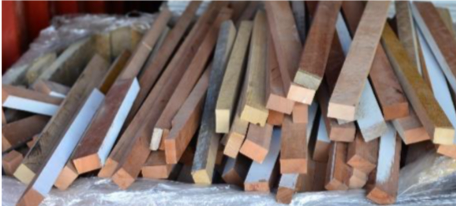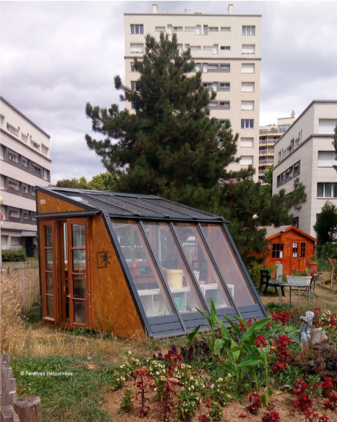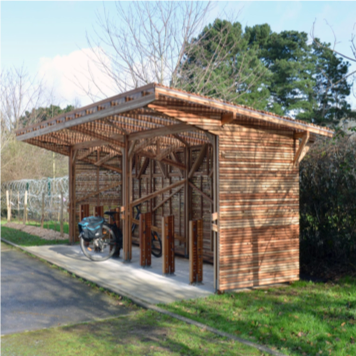

11.03.2022
The reuse of tropical timber species with good durability in a second life is just beginning to emerge. If we look closely, this reuse has many positive externalities, including for the image of tropical timbers, which the "as usable" economy does not value... yet.
For several decades, tropical timbers have been used in constructions, and a considerable quantity of CO2 is thus sequestered, for several more decades in many buildings (1 ton of wood = 1 ton of CO2). With regard to the fight against the greenhouse effect, all this accumulation of construction products made of tropical wood constitutes a common good for the planet because, at the end of their life, the release of their CO2 will know no borders.
The prospect of an ecological collapse linked to the greenhouse effect and the decline of biodiversity is a hypothesis - likely - which considerably revalues this specific common good. As the next 20 years are considered decisive to positively modify the trajectory of the collapse, a new look must be taken now on the management of the end of life of wood products. Landfill is the comfort of a society of abundance now over (even though it is considered in Life Cycle Analyses (LCA) as favourable thanks to the relative conservation of wood in a water saturated environment). As for energy recovery, it is only a last resort because it immediately recharges the atmosphere in CO2.

Long live tropical species of good durability!
Faced with the climate emergency and the loss of biodiversity, the further circularity of tropical timber becomes an important issue, for several reasons. The many tropical species of durability class 1 and 2, and class 3 under certain conditions (wood respectively very resistant, resistant or moderately resistant to attacks by biological agents of wood degradation) are usable in a humid environment without any synthetic biocide, provided that they are implemented according to rules of good design for very long life, well beyond 50 years[1]. There is a specificity of these tropical timbers of good durability because very few species of the temperate zone are usable without biocides in wet environment.
This wood has been slowly built up in tropical forests thanks to a symbiosis of the living, as perfect as fragile, over many years, which makes it very valuable. The fruit of this very complex natural process must be better respected, including during the transformation of wood, and including at the end of life of manufactured products. These massive blocks of biogenic carbon often deserve much better than milling, landfill or incineration. The sustainable management of tropical forests must extend beyond the geographical perimeter of the forest through the respectful management of the woody material extracted from it:
Cities are mines
The further circularity of timber - or the intensity of circularity - tends to concomitantly maximize:
Some constructions have used large quantities of tropical wood products in a serial way (decking, exterior joinery...), which is why we can now consider that "Cities are mines"[2]. But these "deposits" are the opposite of a sawmill or a wood dealer's warehouse: they are extremely diffuse and very heterogeneous (as they were in the rainforest), and require a selective quality deconstruction to extract new viable secondary materials[3].
 Atelier R-ARES Emmaüs
Atelier R-ARES Emmaüs
The "kairos" of reuse
After selective quality deconstruction, few tropical wood construction products will be perfectly suitable for reuse (for the same purpose). On the one hand, the regulatory requirements have changed since their initial manufacture, and on the other hand, certain functions have more or less deteriorated. If "reuse" is not feasible at a reasonable cost, it will be necessary to explore "reuse" through detour (towards other less demanding uses). Finally, when there is no other way out, the dismantling of structures with separation of materials is necessary. Another life for the tropical wood material can then begin, in another form and for another use (this is up-cycling).
The relevance of the realization of a work or a part of a work resulting from the further circularity of wood is the result of a "kairos": this moment - often improbable - when a set of things suddenly crystallizes according to precise conditions. Indeed, the availability of a reuse deposit is very rarely in phase with the realization of a building site whose owner accepts this orientation, thanks to the proposal of an inventive architect, and an encouraging control office.
 100 Détours
100 Détours
New trades, new processes
The balance of environmental gains/insurance risks of reuse is not yet calibrated, due to the lack of a large number of demonstrators and the monetarization of environmental impacts. With economic short-termism prevailing, the balance is clearly tilted towards the comfort zone, which is the rejection of the more advanced circularity of wood.
While some people thought that the use of renewable materials was limitless, the news about the difficulties of wood supply shows us that this is not the case, already for today and, no doubt, even more for tomorrow. The end of the abundance of wood has sounded. A new look at all our wood processing is needed.
We will not go for pleasure to the further circularity of tropical wood (except for some artists). Perhaps we will be seized by the perils to come? In any case the regulatory pressure will force us more and more (in particular in France where the regulatory context evolves favorably with the Extended Producer Responsibility (EPR) building, etc).
Having intermediate storage facilities will be essential to massify solutions. It will be necessary to identify heavy renovation sites, to master selective deconstruction methodologies, to qualify the essential properties, sometimes to re-dry the wood to glue it, etc. The more advanced circularity of tropical wood from urban metabolism is a whole new process, with new trades.
From a purely economic point of view, all this is nothing but madness today... From an environmental point of view, we no longer have a choice.
Frédéric ANQUETIL – 1 mach 2022
[1] See the document file of AFNOR FD P 20-651 « Durabilité des éléments et ouvrages en bois »
[2] Anquetil Frédéric in « Matières Grises », Edition Pavillon de l’Arsenal Paris - 2015
[3] FENECOCIR study - Emmaüs & Ademe - 2018